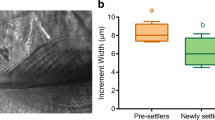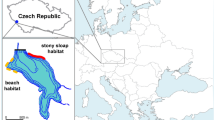Abstract
Estuarine and marine habitat use patterns in the halfbeak Zenarchopterus dunckeri were examined at Iriomote Island, southern Japan, by analyzing otolith Li/Ca and Sr/Ca ratios. The ranges of both Li/Ca and Sr/Ca ratios in juvenile Z. dunckeri from the maximum (30 psu) to minimum (0.5 psu) salinity levels of brackish water estimated from rearing experiments, were compared with those of wild individuals collected from upstream and downstream stations in the Urauchi River estuary. The majority of wild-caught individuals had invariable Li/Ca and Sr/Ca ratios along an otolith transect from the core to the posterior edge, which fell within the otolith Li/Ca and Sr/Ca ranges estimated for estuarine individuals in the rearing experiments, suggesting that such individuals developed within the estuary without migrating to a marine environment at any time, although some downstream-dwelling fish had higher otolith elemental ratios than the predetermined estuarine ranges in the mid transect section. The latter fish may have been accidentally flushed from the estuary into the sea by heavy flood events, subsequently returning to the estuary. The overall results suggested that Z. dunckeri is essentially an estuarine resident, completing its life cycle within an estuarine system.





Similar content being viewed by others
References
Robertson AI, Duke NC (1987) Mangroves as nursery sites: comparisons of the abundance and species composition of fish and crustaceans in mangroves and other nearshore habitats in tropical Australia. Mar Biol 96:193–205
Meynecke JO, Lee SY, Duke NC, Warnken J (2007) Relationships between estuarine habitats and coastal fisheries in Queensland, Australia. Bull Mar Sci 80:773–793
Nagelkerken I, Blaber SJM, Bouillon S, Green P, Haywood M, Kirton LG, Meynecke JO, Pawlik J, Penrose HM, Sasekumar A, Somerfield PJ (2008) The habitat function of mangroves for terrestrial and marine fauna: a review. Aquat Bot 89:155–185
Elliott M, Whifield AK, Potter IC, Blaber SJM, Cyrus DP, Nordlie FG, Harrison TD (2007) The guild approach to categorizing estuarine fish assemblages: a global review. Fish Fish 8:241–268
Blaber SJM (2000) Tropical estuarine fishes: ecology, exploitation and conservation. Blackwell Science, Oxford
Nakamura Y, Horinouchi M, Shibuno T, Tanaka Y, Miyajima T, Koike I, Kurokura H, Sano M (2008) Evidence of ontogenetic migration from mangroves to coral reefs by black tail snapper Lutjanus fulvus: a stable isotope approach. Mar Ecol Prog Ser 355:257–266
Kimirei IA, Nagelkerken I, Mgaya YD, Huijbers CM (2013) The mangrove nursery paradigm revisited: otolith stable isotopes support nursery-to-reef movements by Indo-Pacific fishes. PLoS ONE 8:e66320
Sheaves M (2005) Nature and consequences of biological connectivity in mangrove systems. Mar Ecol Prog Ser 302:293–305
Kimirei IA, Nagelkerken I, Griffioen B, Wagner C, Mgaya YD (2011) Ontogenetic habitat use by mangrove/seagrass-associated coral reef fishes shows flexibility in time and space. Estuar Coast Shelf Sci 92:47–58
Sakabe R, Lyle JM (2010) The influence of tidal cycles and freshwater inflow on the distribution and movement of an estuarine resident fish Acanthopagrus butcheri. J Fish Biol 77:643–660
Nakabo T (ed) (2013) Fishes of Japan with pictorial keys to the species, 3rd edn. Tokai University Press, Hadano (in Japanese)
Meguro K (1972) Northernmost record of the ovoviviparous halfbeak, genus Zenarchopterus, from Okinawa Prefecture, Japan, with some morphological notes. Jpn J Ichthyol 19:186–190
Nanjo K, Kohno H, Sano M (2008) Food habits of fishes in the mangrove estuary of Urauchi River, Iriomote Island, southern Japan. Fish Sci 74:1024–1033
Nanjo K, Kohno H, Nakamura Y, Horinouchi M, Sano M (2014) Differences in fish assemblage structure between vegetated and unvegetated microhabitats in relation to food abundance patterns in a mangrove creek. Fish Sci 80:21–41
Campana SE (1999) Chemistry and composition of fish otoliths: pathways, mechanisms and applications. Mar Ecol Prog Ser 188:263–297
Secor DH, Henderson-Arzapalo A, Piccoli PM (1995) Can otolith microchemistry chart patterns of migration and habitat utilization in anadromous fishes? J Exp Mar Biol Ecol 192:15–33
Elsdon TS, Gillanders BM (2002) Interactive effects of temperature and salinity on otolith chemistry: challenges for determining environmental histories of fish. Can J Fish Aquat Sci 59:1796–1808
Morais P, Dias E, Babaluk J, Antunes C (2011) The migration patterns of the European flounder Platichthys flesus (Linnaeus, 1758) (Pleuronectidae, Pisces) at the southern limit of its distribution range: ecological implications and fishery management. J Sea Res 65:235–246
Gillanders BM (2005) Otolith chemistry to determine movements of diadromous and freshwater fish. Aquat Living Resour 18:291–300
Brown RJ, Severin KP (2009) Otolith chemistry analyses indicate that water Sr:Ca is the primary factor influencing otolith Sr:Ca for freshwater and diadromous fish but not for marine fish. Can J Fish Aquat Sci 66:1790–1808
Tabouret H, Bareille G, Claverie F, Pécheyran C, Prouzet P, Donard OFX (2010) Simultaneous use of strontium: calcium and barium: calcium ratios in otoliths as markers of habitat: application to the European eel (Anguilla anguilla) in the Adour basin, South West France. Mar Environ Res 70:35–45
Tsukamoto K, Arai T (2001) Facultative catadromy of the eel Anguilla japonica between freshwater and seawater habitats. Mar Ecol Prog Ser 220:265–276
Limburg KE (1995) Otolith strontium traces environmental history of subyearling American shad Alosa sapidissima. Mar Ecol Prog Ser 119:25–35
Thorrold SR, Jones CM, Campana SE, McLaren JW, Lam JW (1998) Trace element signatures in otoliths record natal river of juvenile American shad (Alosa sapidissima). Limnol Oceanogr 43:1826–1835
Kraus RT, Secor DH (2004) Incorporation of strontium into otoliths of an estuarine fish. J Exp Mar Biol Ecol 302:85–106
Hicks AS, Closs GP, Swearer SE (2010) Otolith microchemistry of two amphidromous galaxiids across an experimental salinity gradient: a multi-element approach for tracking diadromous migrations. J Exp Mar Biol Ecol 394:86–97
Tanner SE, Reis-Santos P, Vasconcelos RP, Fonseca VF, Franca S, Cabral HN, Thorrold SR (2013) Does otolith geochemistry record ambient environmental conditions in a temperate tidal estuary? J Exp Mar Biol Ecol 441:7–15
Hamer PA, Jenkins GP (2007) Comparison of spatial variation in otolith chemistry of two fish species and relationships with water chemistry and otolith growth. J Fish Biol 71:1035–1055
Yamane K, Shirai K, Nagakura Y, Yamaguchi M, Takita A, Horii T, Tanaka N, Yamane S, Arai T, Otake T (2010) Spatial variation of otolith elemental compositions in Pacific herring Clupea pallasii. Aquat Biol 10:283–290
Yamane K, Shirai K, Nagkura Y, Otake T (2012) Assessing the usefulness of otolith elemental compositions for evaluating the population structure of the Pacific herring Clupea pallasii in northern Japan. Fish Sci 78:295–307
Shirai K, Takahata N, Yamamoto H, Omata T, Sasaki T, Sano Y (2008) Novel analytical approach to bivalve shell biogeochemistry: a case study of hydrothermal mussel shell. Geochem J 43:413–420
Little C (2000) The biology of soft shore and estuaries. Oxford University Press, New York
Secor DH, Rooker JR (2000) Is otolith strontium a useful scalar of life cycles in estuarine fishes? Fish Res 46:359–371
Elsdon TS, Gillanders BM (2003) Reconstructing migratory patterns of fish based on environmental influences on otolith chemistry. Rev Fish Biol Fish 13:217–235
Buckel JA, Sharack BL, Zdanowicz VS (2004) Effect of diet on otolith composition in Pomatomus saltatrix, an estuarine piscivore. J Fish Biol 64:1469–1484
Elsdon TS, Wells BK, Campana SE, Gillanders BM, Jones CM, Limburg KE, Walther BD (2008) Otolith chemistry to describe movements and life-history parameters of fishes: hypotheses, assumptions, limitations and inferences. Oceanogr Mar Biol Annu Rev 46:297–330
Milton DA, Chenery SR (2001) Sources and uptake of trace metals in otoliths of juvenile barramundi Lates calcarifer. J Exp Mar Biol Ecol 264:47–65
Walsh CT, Reinfelds IV, Ives MC, Gray CA, West RJ, van der Meulen DE (2013) Environmental influences on the spatial ecology and spawning behaviour of an estuarine-resident fish, Macquaria colonorum. Estuar Coast Shelf Sci 118:60–71
Acknowledgments
We are grateful to Ken Sakihara, Akira Mizutani and the Okinawa Regional Research Center, Tokai University, for assistance with the fieldwork. Constructive comments on the manuscript from Kotaro Shirai, Ken Okamoto, Shigeru Aoki, Graham Hardy and two anonymous reviewers were much appreciated. This study was supported by a GCOE Asian Conservation Ecology between Kyusyu University and the University of Tokyo and a Grant-in-Aid for Scientific Research (A) from the Japan Society for the Promotion of Science (No. 26252027).
Author information
Authors and Affiliations
Corresponding author
Rights and permissions
About this article
Cite this article
Kanai, T., Nanjo, K., Yamane, K. et al. Utilization patterns of estuarine and marine habitats by the halfbeak Zenarchopterus dunckeri at Iriomote Island, southern Japan, evaluated from otolith microchemistry. Fish Sci 80, 1231–1239 (2014). https://doi.org/10.1007/s12562-014-0797-8
Received:
Accepted:
Published:
Issue Date:
DOI: https://doi.org/10.1007/s12562-014-0797-8




